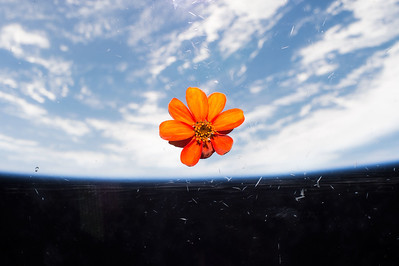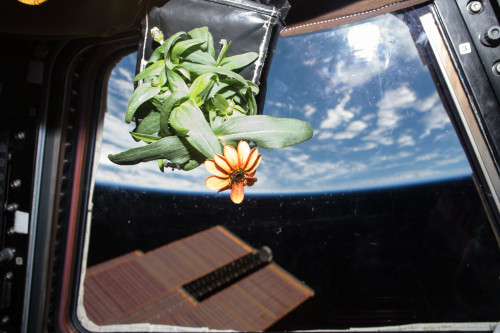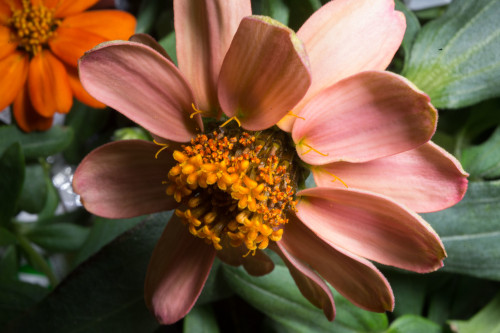Astronaut Tweets
Astronaut tweets























More Posts from Fillthevoid-with-space and Others





When the sun sets on Stonehenge on the shortest day of the year, it’s rays align with several important stones. Twice a year, the streets of Manhattan also line up with the setting sun, a phenomenon dubbed “Manhattanhenge”. Really, most cities with grid systems will see a similar effect (though it’s most dramatic in cities with tall buildings and a view of the true horizon). You can use a great tool called The Photographer’s Ephemeris to find out the “henge” dates for your city grid - or even individual streets.
Yesterday, (Friday, January 24th) the sun lined up with New York Avenue, a street in DC that runs diagonally up to the White House. (The orange line indicates alignment with the setting sun).
I went out with our multimedia intern Meg Vogel, and captured some images of the sun setting in line with a rather Stonehenge-y sculpture that sits in the middle of that street.
Here are dates for sunset “henge” events in some cities this year:
Manhattan May 25th, July 17th
Philadelphia April 5th, September 6th
Washington DC March 18th, September 24th
Chicago March 16th, September 26th
Phoenix March 20th, September 22nd
Portland, OR March 18th, September 24th
Is your city/town a grid? When’s your henge?

A teenager designed a pocket-sized satellite that will fly on a NASA mission
An 18-year-old created the world’s lightest functioning satellite, and it’s going to be launched on a real NASA mission next month.
Rifath Sharook, who is from Tamil Nadu, India, made the pocket-sized satellite for a competition called Cubes in Space, which is an international design challenge that asks students aged 11 to 18 to fit their space-worthy invention inside a 13-foot cube.
The pocket-sized 3-D printed satellite is much smaller than that. It weighs just 0.14 pounds and will measure the rotation, acceleration and magnetosphere of Earth, Sharook told Business Standard. Read more (5/17/17)
follow @the-future-now
I saw the picture and I thought it was a photo of the space between a Venetian blind and a window frame but no. No. It was a moon between the rings of Saturn.
Star Discovered in Closest Known Orbit Around Likely Black Hole
NASA - Chandra X-ray Observatory patch. Astronomers have found evidence for a star that whips around a black hole about twice an hour. This may be the tightest orbital dance ever witnessed for a likely black hole and a companion star.
Image above: Artist’s illustration of a star found in the closest orbit known around a black hole in the globular cluster named 47 Tucanae. Image Credits: X-ray: NASA/CXC/University of Alberta/A.Bahramian et al.; Illustration: NASA/CXC/M.Weiss. This discovery was made using NASA’s Chandra X-ray Observatory as well as NASA’s NuSTAR and CSIRO’s Australia Telescope Compact Array (ATCA). The close-in stellar couple – known as a binary – is located in the globular cluster 47 Tucanae, a dense cluster of stars in our galaxy about 14,800 light years from Earth. While astronomers have observed this binary for many years, it wasn’t until 2015 that radio observations with the ATCA revealed the pair likely contains a black hole pulling material from a companion star called a white dwarf, a low-mass star that has exhausted most or all of its nuclear fuel. New Chandra data of this system, known as X9, show that it changes in X-ray brightness in the same manner every 28 minutes, which is likely the length of time it takes the companion star to make one complete orbit around the black hole. Chandra data also shows evidence for large amounts of oxygen in the system, a characteristic feature of white dwarfs. A strong case can, therefore, be made that the companion star is a white dwarf, which would then be orbiting the black hole at only about 2.5 times the separation between the Earth and the Moon. “This white dwarf is so close to the black hole that material is being pulled away from the star and dumped onto a disk of matter around the black hole before falling in,” said first author Arash Bahramian of the University of Alberta in Edmonton, Canada, and Michigan State University in East Lansing. “Luckily for this star, we don’t think it will follow this path into oblivion, but instead will stay in orbit.” Although the white dwarf does not appear to be in danger of falling in or being torn apart by the black hole, its fate is uncertain.
Chandra X-ray Observatory. Image Credits: NASA/CXC
“Eventually so much matter may be pulled away from the white dwarf that it ends up only having the mass of a planet,” said co-author Craig Heinke, also of the University of Alberta. “If it keeps losing mass, the white dwarf may completely evaporate.” How did the black hole get such a close companion? One possibility is that the black hole smashed into a red giant star, and then gas from the outer regions of the star was ejected from the binary. The remaining core of the red giant would form into a white dwarf, which becomes a binary companion to the black hole. The orbit of the binary would then have shrunk as gravitational waves were emitted, until the black hole started pulling material from the white dwarf. The gravitational waves currently being produced by the binary have a frequency that is too low to be detected with Laser Interferometer Gravitational-Wave Observatory, LIGO, that has recently detected gravitational waves from merging black holes. Sources like X9 could potentially be detected with future gravitational wave observatories in space. An alternative explanation for the observations is that the white dwarf is partnered with a neutron star, rather than a black hole. In this scenario, the neutron star spins faster as it pulls material from a companion star via a disk, a process that can lead to the neutron star spinning around its axis thousands of times every second. A few such objects, called transitional millisecond pulsars, have been observed near the end of this spinning up phase. The authors do not favor this possibility as transitional millisecond pulsars have properties not seen in X9, such as extreme variability at X-ray and radio wavelengths. However, they cannot disprove this explanation. “We’re going to watch this binary closely in the future, since we know little about how such an extreme system should behave”, said co-author Vlad Tudor of Curtin University and the International Centre for Radio Astronomy Research in Perth, Australia. “We’re also going to keep studying globular clusters in our galaxy to see if more evidence for very tight black hole binaries can be found.” A paper describing these results was recently accepted for publication in the Monthly Notices of the Royal Astronomical Society and is available online: https://arxiv.org/abs/1702.02167 NASA’s Marshall Space Flight Center in Huntsville, Alabama, manages the Chandra program for NASA’s Science Mission Directorate in Washington. The Smithsonian Astrophysical Observatory in Cambridge, Massachusetts, controls Chandra’s science and flight operations. Read More from NASA’s Chandra X-ray Observatory: http://chandra.harvard.edu/photo/2017/47tuc/ For more Chandra images, multimedia and related materials, visit: http://www.nasa.gov/chandra Images (mentioned), Text, Credits: NASA/Lee Mohon/Marshall Space Flight Center/Molly Porter/Chandra X-ray Center/Megan Watzke. Greetings, Orbiter.ch Full article
Spacewalkers Successfully Connect Adapter for Commercial Crew Vehicles
ISS - Expedition 50 Mission patch / EVA - Extra Vehicular Activities patch. March 30, 2017 Expedition 50 Commander Shane Kimbrough and Flight Engineer Peggy Whitson of NASA concluded their spacewalk at 2:33 p.m. EDT. During the spacewalk, which lasted just over seven hours, the two astronauts successfully reconnected cables and electrical connections on the Pressurized Mating Adapter-3. PMA-3 will provide the pressurized interface between the station and the second of two international docking adapters to be delivered to the complex to support the dockings of U.S. commercial crew spacecraft in the future.
Image above: Spacewalkers Shane Kimbrough (spacesuit with red stripe on legs) and Peggy Whitson are pictured shortly after exiting the Quest airlock this morning. Image Credits: @Thom_Astro. The duo were also tasked with installing four thermal protection shields on the Tranquility module of the International Space Station. The shields were required to cover the port where the PMA-3 was removed earlier in the week and robotically installed on the Harmony module. During the spacewalk, one of the shields was inadvertently lost. The loss posed no immediate danger to the astronauts and Kimbrough and Whitson went on to successfully install the remaining shields on the common berthing mechanism port. A team from the Mission Control Center at NASA’s Johnson Space Center in Houston devised a plan for the astronauts to finish covering the port with the PMA-3 cover Whitson removed earlier in the day. The plan worked, and the cover was successfully installed, providing thermal protection and micrometeoroid and orbital debris cover for the port. To round out the spacewalk, Kimbrough and Whitson also installed a different shield around the base of the PMA-3 adapter for micrometeoroid protection. The shield was nicknamed a cummerbund as it fits around the adapter similar to a tuxedo’s cummerbund worn around the waist.
Image above: Astronaut Peggy Whitson signs her autograph near an Expedition 50 mission patch attached to the inside the International Space Station. Image Credit: NASA. Having completed her eighth spacewalk, Whitson now holds the record for the most spacewalks and accumulated time spacewalking by a female astronaut. Spacewalkers have now spent a total of 1,243 hours and 42 minutes outside the station during 199 spacewalks in support of assembly and maintenance of the orbiting laboratory. Related links: International docking adapters: https://www.nasa.gov/feature/meet-the-international-docking-adapter Peggy Whitson spacewalk record: https://blogs.nasa.gov/spacestation/2017/03/29/astronaut-peggy-whitson-set-to-break-spacewalk-record-thursday/ Space Station Research and Technology: https://www.nasa.gov/mission_pages/station/research/index.html International Space Station (ISS): https://www.nasa.gov/mission_pages/station/main/index.html Images (mentioned), Text, Credits: NASA/Mark Garcia. Best regards, Orbiter.ch Full article



Take a moment, look outside your window. 🌷🌼
Today is the #FirstDayOfSpring in the Northern Hemisphere, also known as the vernal equinox.
#DYK Earth’s tilted axis causes the season? Throughout the year, different parts of Earth receive the Sun’s most direct rays. So, when the North Pole tilts toward the Sun, it’s summer in the Northern Hemisphere. And when the South Pole tilts toward the Sun, it’s winter in the Northern Hemisphere.
These images are of Zinnias. They are part of the flowering crop experiment that began aboard the International Space Station on Nov. 16, 2015, when NASA astronaut Kjell Lindgren activated the Veggie system and its rooting “pillows” containing zinnia seeds.
Make sure to follow us on Tumblr for your regular dose of space: http://nasa.tumblr.com.
My microphone just arrived! Now to set it up and figure out how the hell it works....
-
 alaskanskald reblogged this · 1 week ago
alaskanskald reblogged this · 1 week ago -
 alaskanskald liked this · 1 week ago
alaskanskald liked this · 1 week ago -
 senamer reblogged this · 1 week ago
senamer reblogged this · 1 week ago -
 trulymightypotato reblogged this · 1 week ago
trulymightypotato reblogged this · 1 week ago -
 theaterm reblogged this · 1 week ago
theaterm reblogged this · 1 week ago -
 theaterm liked this · 1 week ago
theaterm liked this · 1 week ago -
 iolaussharpe-24 reblogged this · 1 week ago
iolaussharpe-24 reblogged this · 1 week ago -
 iolaussharpe-24 liked this · 1 week ago
iolaussharpe-24 liked this · 1 week ago -
 munsons-mayhem28 reblogged this · 1 week ago
munsons-mayhem28 reblogged this · 1 week ago -
 olyrik liked this · 1 week ago
olyrik liked this · 1 week ago -
 ssp3ctor reblogged this · 1 week ago
ssp3ctor reblogged this · 1 week ago -
 ssp3ctor liked this · 1 week ago
ssp3ctor liked this · 1 week ago -
 musicofthenightphantomoftheopera liked this · 1 week ago
musicofthenightphantomoftheopera liked this · 1 week ago -
 garglinggorilla reblogged this · 1 week ago
garglinggorilla reblogged this · 1 week ago -
 pokemonandcatsmostly reblogged this · 1 week ago
pokemonandcatsmostly reblogged this · 1 week ago -
 bixshits liked this · 1 week ago
bixshits liked this · 1 week ago -
 scaleyweasel liked this · 1 week ago
scaleyweasel liked this · 1 week ago -
 jonnyconstantine reblogged this · 1 week ago
jonnyconstantine reblogged this · 1 week ago -
 jonnyconstantine liked this · 1 week ago
jonnyconstantine liked this · 1 week ago -
 rosecentaur1916 reblogged this · 1 week ago
rosecentaur1916 reblogged this · 1 week ago -
 rosecentaur1916 liked this · 1 week ago
rosecentaur1916 liked this · 1 week ago -
 scoopiii liked this · 1 week ago
scoopiii liked this · 1 week ago -
 virtie333 reblogged this · 1 week ago
virtie333 reblogged this · 1 week ago -
 light-angel liked this · 1 week ago
light-angel liked this · 1 week ago -
 alltoodameron liked this · 1 week ago
alltoodameron liked this · 1 week ago -
 soft-girl-musings liked this · 1 week ago
soft-girl-musings liked this · 1 week ago -
 my-secret-shame reblogged this · 1 week ago
my-secret-shame reblogged this · 1 week ago -
 basiliskfeathers reblogged this · 1 week ago
basiliskfeathers reblogged this · 1 week ago -
 irisensata reblogged this · 1 week ago
irisensata reblogged this · 1 week ago -
 irisensata liked this · 1 week ago
irisensata liked this · 1 week ago -
 probably-a-plant-thing liked this · 1 week ago
probably-a-plant-thing liked this · 1 week ago -
 felinelun liked this · 1 week ago
felinelun liked this · 1 week ago -
 zenstarling liked this · 1 week ago
zenstarling liked this · 1 week ago -
 christines-dairy liked this · 1 week ago
christines-dairy liked this · 1 week ago -
 thebeeesknees495 liked this · 1 week ago
thebeeesknees495 liked this · 1 week ago -
 compass-rose-posts liked this · 1 week ago
compass-rose-posts liked this · 1 week ago -
 kitapparently reblogged this · 1 week ago
kitapparently reblogged this · 1 week ago -
 elirazantys reblogged this · 1 week ago
elirazantys reblogged this · 1 week ago -
 aestheti-kitty reblogged this · 1 week ago
aestheti-kitty reblogged this · 1 week ago -
 aestheti-kitty liked this · 1 week ago
aestheti-kitty liked this · 1 week ago -
 tombtombtombtombtomb reblogged this · 1 week ago
tombtombtombtombtomb reblogged this · 1 week ago -
 kurapikasrabies liked this · 1 week ago
kurapikasrabies liked this · 1 week ago -
 picturemecountingcards reblogged this · 1 week ago
picturemecountingcards reblogged this · 1 week ago -
 ajarofpickledtears reblogged this · 1 week ago
ajarofpickledtears reblogged this · 1 week ago -
 eternalsunshineofthetwistedminds reblogged this · 1 week ago
eternalsunshineofthetwistedminds reblogged this · 1 week ago -
 eternalsunshineofthetwistedminds liked this · 1 week ago
eternalsunshineofthetwistedminds liked this · 1 week ago -
 stardustmorozov reblogged this · 1 week ago
stardustmorozov reblogged this · 1 week ago -
 poobur79 reblogged this · 1 week ago
poobur79 reblogged this · 1 week ago -
 rehfan liked this · 1 week ago
rehfan liked this · 1 week ago
A podcast project to fill the space in my heart and my time that used to be filled with academic research. In 2018, that space gets filled with... MORE SPACE! Cheerfully researched, painstakingly edited, informal as hell, definitely worth everyone's time.
243 posts


